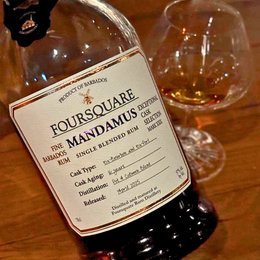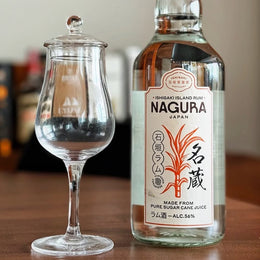
We're headed to Ecuador, courtesy of Velier! Well, our noses and palate anyway.
This is El Amparo, Velier's latest haul from Ecuador's Jipijapa area in the Manabi region located in west Ecuador. It's a white rum, or as it's labelled, Ron Equatorial, and Velier refers to it also as aguardiente. Aguardiente, which translates as "firewater" in Spanish, is actually a rather broad category of fermented and distilled spirits that can be produced from the must and/or macerations of a wide variety of agricultural produce that can include fruits and grains. It's not a term that's clearly defined or regulated to my understanding, but is the most commonly used term for distilled spirits in Spanish-influenced regions.


According to an interview with Velier's Export Manager, Daniele Biondi, it was mentioned that Velier had begun to take a closer look into Latin American countries when they had heard of a significant number of distillation stills dotting around the area, operated by small and independent craft producers who had eschewed the more conventional Spanish or light style rums. When they were told that these small producers held on to ancestral methods of cane spirit making, you can bet they got themselves over there pretty quickly.
Velier then says that when they begun studying Ecuador, they had gotten hold of tasting samples from 18 different distilleries, and went through the stages of tasting them, before finally concluding on an El Amparo that was produced by Carlos Baque Zorrilla.

Carlos Baque Zorrilla, whose name is on the label of the El Amparo (a very kind and also transparency promoting gesture that is valued by all) is the third generation producer of this aguardiente. The name "El Amparo" is taken to mean "refuge" or "shelter", and is also the name of the estate on which the aguardiente is produced - the name being given by Zorrilla's grandfather. In fact, this very bottling that has been distributed by Velier celebrates the 60th anniversary of the Zorrilla family's aguardiente-making tradition.
Going back to ancestral traditions, the aguardiente here comes from sugarcane harvested between September and January, with the canes being 18 months old, and only using a machete. The canes are cut 15 cm above the ground to ensure that ripened and non-acidic cane is used, and also leaving sufficient cane bud for future harvesting. Fermentation happens spontaneously in 1000 to 3000 litre containers with wild yeasts, and can range from 5 to 7 days, before it is distilled using a 500 litre copper still. Velier also notes that the copper still is rather unique as the top of the column is equipped with a funnel-shaped component which is said to provide opposition to the distilled vapours that then helps to concentrate the aromas.
For the El Amparo, it's just one distillation run, producing spirit at 60% ABV, which is then bottled as such.
Let's give it a go!
El Amparo Ron Equatorial, Carlos Baque Zorrilla, 60% ABV - Review

Tasting Notes
Colour: Water
Aroma: Thick, heady notes of vanilla, cane juice, vegetal but incredibly aromatic - crushed sugarcane, fondant or frosting, a light bit of green olives, it’s almost floral as well - heavy white florals of frangipani. There’s an incredible mellowness and roundedness about this - all of those notes are woven together into one singularity, a really creamy singularity. A light diesel and petrol quality to it as well. Over time it brightens up with some lemon blossoms, green bananas, with more of that olive brine and black olive tapenade coming through.
Taste: A nice spiciness that gives way to much more sweetness - sugar syrup, vanilla concentrate, fondant, liquorice candy, it’s even alittle gummy-ish and chewy. More of that higher tone petrol and marker pens. It’s quite a bit sweeter, still incredibly rounded and silky. There’s some herbaceousness but it’s almost woven into candy - basil in particular strikes out.
Finish: More olive brine here. It’s incredibly floral, still very much that sweet, candied quality about it. Chewy liquorice, fondant, sugarcane juice and crushed sugarcane, diesel. It keeps on evolving with all these strong floral notes of banana blossoms and green bananas, and herbaceous dried basil notes that are caked in candy.

My Thoughts
The El Amparo is really quite impressive, but you’ve got to give it a good amount of time to develop and you’ve got to have several sips because what we have here isn’t something that’s distinctly unusual or atypical, rather it’s notes we’re familiar with but delivered with a ridiculous amount of richness and mellowness, in this very rounded and candied quality. It’s like splitting hairs trying to tease out the individual notes.
It’s not squeaky, or particularly dirty, but it’s heavy on the sugarcane sweetness which forms the base to which it heaps on all these florals and herbaceousness. Its overwhelming flavour is that of sweetness, which makes it much more approachable than most white rums, and to that end you won’t find much in the way of sharpness, bitterness, sourness, astringency, medicinal notes or savouriness here - it is predominantly candy.
What is particularly impressive, aside from the mellowness of the aromas, is the finish which keeps on developing, but also has this chewy quality to it that I found very satisfying, almost like chewing on licorice candy.
Overall, this isn’t one of your super funky, high ester white rums, nor is it petrol disguised as rum, rather its classic in its profile but rendered beautifully with an atypical richness, roundedness and mellowness. It’s basically licorice candy with basil and white flowers if there was ever such a thing.
Kanpai!

@111hotpot







